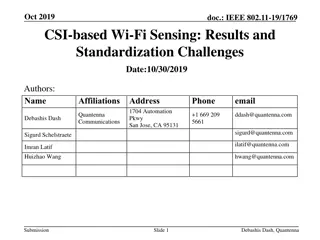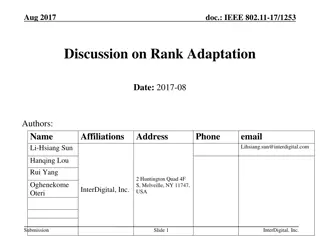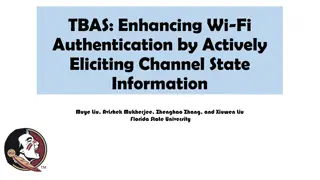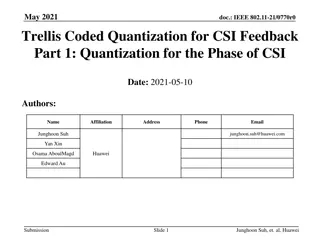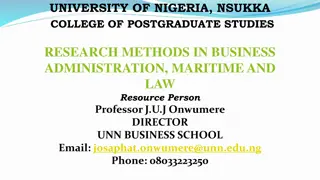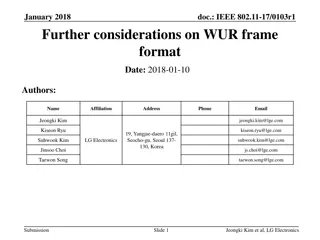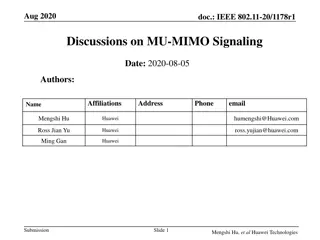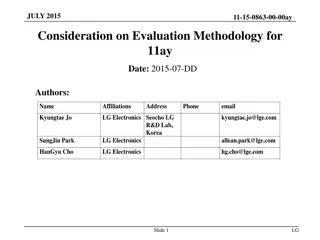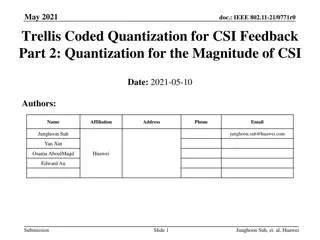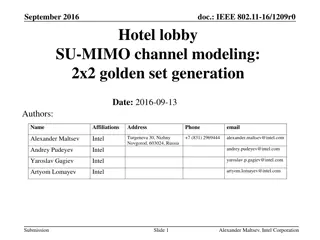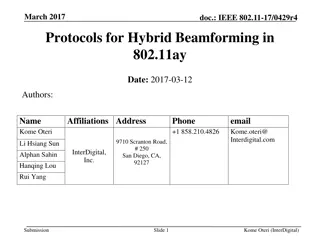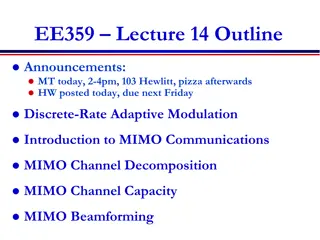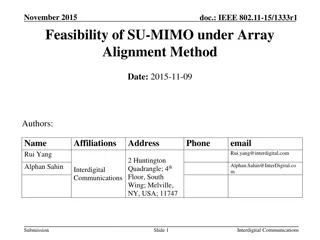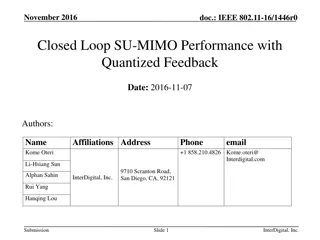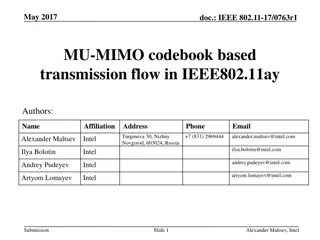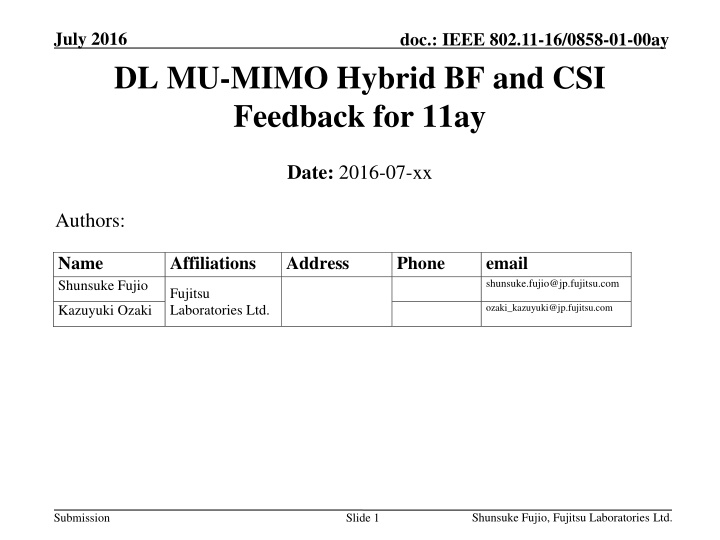
IEEE 802.11ay DL MU-MIMO Hybrid BF and CSI Feedback
Explore the DL MU-MIMO scheme and CSI feedback for IEEE 802.11ay introduced in July 2016. Delve into a new hybrid BF method that controls pencil beams, enabling DL MU-MIMO without CSI feedback. Understand the implications of CSI feedback overhead and the role it plays in managing interference in MU-MIMO operations.
Download Presentation

Please find below an Image/Link to download the presentation.
The content on the website is provided AS IS for your information and personal use only. It may not be sold, licensed, or shared on other websites without obtaining consent from the author. If you encounter any issues during the download, it is possible that the publisher has removed the file from their server.
You are allowed to download the files provided on this website for personal or commercial use, subject to the condition that they are used lawfully. All files are the property of their respective owners.
The content on the website is provided AS IS for your information and personal use only. It may not be sold, licensed, or shared on other websites without obtaining consent from the author.
E N D
Presentation Transcript
July 2016 doc.: IEEE 802.11-16/0858-01-00ay DL MU-MIMO Hybrid BF and CSI Feedback for 11ay Date: 2016-07-xx Authors: Name Shunsuke Fujio Affiliations Address Phone email shunsuke.fujio@jp.fujitsu.com Fujitsu Laboratories Ltd. ozaki_kazuyuki@jp.fujitsu.com Kazuyuki Ozaki Shunsuke Fujio, Fujitsu Laboratories Ltd. Submission Slide 1
July 2016 doc.: IEEE 802.11-16/0858-01-00ay Introduction In [1], DL MU-MIMO scheme and CSI feedback for 802.11ay was introduced. DL MU-MIMO throughput might be degraded due to CSI feedback overhead. In this presentation, we consider a new hybrid BF method which controls multiple pencil beams, and we show it enables DL MU- MIMO w/o CSI feedback. Shunsuke Fujio, Fujitsu Laboratories Ltd. Submission Slide 2
July 2016 doc.: IEEE 802.11-16/0858-01-00ay CSI Feedback in 11ad CSI can be reported in Channel Measurement Feedback element of BRP frame in 11ad Payload size of the frame is calculated as MAC Header(28) + FCS(4) + Body(14 + x) = 46 + x [octets] x: Channel Measurement Feedback Element size BRP frame Octets 2 2 6 6 6 2 4 0-2328 4 Frame Control Sequence Control HT Frame Body Duration Address 1 Address 2 Address 3 FCS Control Octets 1 1 1 4 7 x CategoryUnprotected DMG Action Dialog Token BRP Request field DMG Beam Refinement element Channel Measurement Feedback element 1 1 2NtapsNmeas Nmeas Ntaps Nmeas Octets Nmeas: number of measurements Ntaps: number of taps Element ID Channel Measurement Tap Delay Sector ID Order Length SNR Shunsuke Fujio, Fujitsu Laboratories Ltd. Submission Slide 3
July 2016 doc.: IEEE 802.11-16/0858-01-00ay CSI Feedback Overhead CSI feedback consumes about 3us ~ 4us per STA when each STA reports SNR & Channel measurement with MCS4 in 11ad STF + CEF + Header : 2.5us Channel Measurement Feedback element Payload length: 0.4 ~ 1.7us 1 1 2Nmeas Nmeas Octets Payload size: 46 + x octets Element ID Channel Measurement Length SNR Channel Measurement Feedback element size(x): 2 + Nmeas + 2Nmeas octets (Nmeas: up to 64) (when Ntaps = 1) MCS4 (Single Carrier): data rate is 1152Mbps Total duration of CSI feedback from all STAs in MU-MIMO operation is estimated as several ten [us] or more. Thus, DL MU-MIMO operation that cause little interference between STAs w/o CSI feedback is preferred. Shunsuke Fujio, Fujitsu Laboratories Ltd. Submission Slide 4
July 2016 doc.: IEEE 802.11-16/0858-01-00ay DL MU-MIMO w/o CSI When AP forms broad beams for DL MU-MIMO operation, large interference occurs between beams CSI is important to mitigate interference But when AP forms sharp beams for DL MU-MIMO operation, large interference does not occur between beams CSI is not needed MU-MIMO with broad beam MU-MIMO with sharp beam STA STA large little AP AP interference interference STA STA Shunsuke Fujio, Fujitsu Laboratories Ltd. Submission Slide 5
July 2016 doc.: IEEE 802.11-16/0858-01-00ay Interleaved Hybrid BF Method We propose an interleaved hybrid BF method. Multiple pencil beams can be created by applying digital beamforming in an interleaved subarray configuration. Proposed hybrid BF Conventional hybrid BF B A A B D/A D/A D/A D/A A-B A+B digital beamforming digital beamforming B B A A Shunsuke Fujio, Fujitsu Laboratories Ltd. Submission Slide 6
July 2016 Principle of Interleaved HBF Method doc.: IEEE 802.11-16/0858-01-00ay In the interleaved hybrid BF, a beam of each subarray has main lobe and grating lobes because of large antenna spacing. Phase difference between the main lobe and each grating lobe is different from each subarray. Thus, by combining the beams via digital beamforming, each user s signal can be transmitted in each of the main lobe or the grating lobes directions. B subarray#1 subarray#2 A phase:0deg phase:180deg phase:0deg phase:0deg A+B A-B D/A D/A D/A D/A D/A D/A digital beamforming B A B A B A Shunsuke Fujio, Fujitsu Laboratories Ltd. Submission Slide 7
July 2016 Beam Pattern of Interleaved HBF doc.: IEEE 802.11-16/0858-01-00ay Interleaved HBF can create very sharp beams, which cause little interference to each other in main lobe region. Thus, MU-MIMO operation w/o CSI feedback is possible by using this method. Beam pattern (3dB beam width: 1.6degrees) 64 antennas 8 subarrays 0.5 wavelength antenna spacing Shunsuke Fujio, Fujitsu Laboratories Ltd. Submission Slide 8
July 2016 doc.: IEEE 802.11-16/0858-01-00ay Conclusions CSI feedback overhead in DL MU-MIMO operation is evaluated. A new interleaved hybrid BF method for MU-MIMO is proposed. Shunsuke Fujio, Fujitsu Laboratories Ltd. Submission Slide 9
July 2016 doc.: IEEE 802.11-16/0858-01-00ay STRAW POLL 1 Do you agree to insert the following text into the SFD 11ay supports MU-MIMO BF with or without CSI feedback. Yes No Abstain Shunsuke Fujio, Fujitsu Laboratories Ltd. Submission Slide 10
July 2016 doc.: IEEE 802.11-16/0858-01-00ay Reference [1] IEEE 802.11-16/0405r1, 11ay DL MU-MIMO BF Training and User Selection Shunsuke Fujio, Fujitsu Laboratories Ltd. Submission Slide 11
July 2016 doc.: IEEE 802.11-16/0858-01-00ay Appendix Shunsuke Fujio, Fujitsu Laboratories Ltd. Submission Slide 12
July 2016 Principle of Interleaved HBF Method 1 doc.: IEEE 802.11-16/0858-01-00ay In the interleaved hybrid BF, each subarray creates main lobe and grating lobes, and their phases are different from each subarray beam pattern of subarray#i ??? = ?=0 grating lobes are formed in direction ?? that satisfy ????? ????0= ? beam pattern in ??: ???? = ?0:beam direction :wavelength ?/? 1??? ?2?? ?? + ?? ???? ????0 ? ?? (? = 1, 2, ) (??=0: main lobe direction) ? ???? ?2??? ? phase:0deg phase:0deg phase:0deg phase:180deg d d K K D/A D/A D/A D/A M M B A B A Shunsuke Fujio, Fujitsu Laboratories Ltd. Submission Slide 13
July 2016 Principle of Interleaved HBF Method 2 doc.: IEEE 802.11-16/0858-01-00ay The beams of subarrays are combined with inter-subarray coding weight for equal-phase combining in n-th lobe direction = ? ?? ? = ? 0 ?? ? ? ? 1??????? ?2??? ? ? ?=0 ? 1??? ?2?? ? ? ?=0 ?= ? In this method, multiple beams without inter-beam interference can be created in each directions satisfy ????? ?????= ? ? ?? 2B = (A+B) (A-B) 2A = (A+B) + (A-B) K A-B A+B D/A D/A M Inter-subarray coding B A Shunsuke Fujio, Fujitsu Laboratories Ltd. Submission Slide 14



